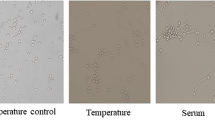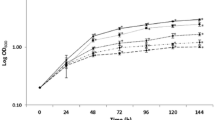Abstract
Fungal infection remains a major problem worldwide, yet treatment options are limited owing to the lack of effective drugs, the significant toxicity of available compounds, and the emergence of drug resistance. The low toxicity of calcofluor white (CFW) is an attractive antifungal compound for its known inhibitive effects on trichophyton rubrum and candida albicans growth. However, the efficacy of CFW is limited in most cases. In order to search for effective means to improve its efficacy, using saccharomyces cerevisiae as a model, we have used microarrays to examine the cell’s response when treated with CFW on the genome scale. We found that both the PKC-SLT2 (i.e, protein kinase C-mitogen activated protein kinase) and the glycogen metabolic pathways are activated upon CFW treatment. These results suggest that the key components in these pathways could be targeted by other drugs to counter the cell’s compensative response, thus to further substantiate the inhibitive effect of CFW on fungal growth, which may lead to treatment regimens with improved efficacy of this compound in clinical applications.
Similar content being viewed by others
References
Miceli M H, Diza J A, Lee S A. Emerging opportunistic yeast infections [J]. The Lancet Infectious Diseases, 2011, 11(2): 142–151.
Brown G D, Denning D W, Gow N A R, et al. Hidden killers: Human fungal infections [J]. Science Translational Medicine, 2012, 4(165): 165rv13.1-5.
Havlickova B, Czaika V A, Friedrich M. Epidemiological trends in skin mycoses worldwide [J]. Mycoses, 2008, 51(s4): 2–15.
Hope W, Natarajan P, Goodwin L. Invasive fungal infections [J]. Clinical Medicine, 2013, 13(5): 507–510.
Hart R, Bell-Syer S E, Crawford F, et al. Systematic review of topical treatments for fungal infections of the skin and nails of the feet [J]. British Medical Journal, 1999, 319(7202): 79–82.
Westerberg D P, Voyack M J. Onychomycosis: Current trends in diagnosis and treatment [J]. American Family Physician, 2013, 88(11): 762–770.
Kumar R S, Ganvir S, Hazarey V. Candida and calcofluor white: Study in precancer and cancer [J]. Journal of Oral and Maxillo Facial Pathology, 2009, 13(1): 2–8.
Kingsbury J M, Heitman J, Pinnell S R. Calcofluor white combination antifungal treatments for trichophyton rubrum and candida albicans [J]. PLoS One, 2012, 7(7): e39405.
Yago J I, Lin C H, Chung K R. The SLT2 mitogenactivated protein kinase-mediated signalling pathway governs conidiation, morphogenesis, fungal virulence and production of toxin and melanin in the tangerine pathotype of Alternaria alternata [J]. Molecular Plant Pathology, 2011, 12(7): 653–665.
Bartnickigarcia S, Persson J, Chanzy H. An electron microscope and electron diffraction study of the effect of calcofluor and congo red on the biosynthesis of chitin in vitro [J]. Archives of Biochemistry and Biophysics, 1994, 310(1): 6–15.
Brasch J, Kreiselmaier I, Christophers E. Inhibition of dermatophytes by optical brighteners [J]. Mycoses, 2003, 46(3–4): 120–125.
Miura F, Kawaguchi N, Sese J, et al. A largescale full-length cDNA analysis to explore the budding yeast transcriptome [J]. Proceedings of the National Academy of Sciences of the United States of America, 2006, 103(47): 17846–17851.
Olivares-Hernandez R, Usaite R, Nielsen J. Integrative analysis using proteome and transcriptome data from yeast to unravel regulatory patterns at posttranscriptional level [J]. Biotechnology and Bioengineering, 2010, 107(5): 865–875.
Roncero C, Valdivieso M H, Ribas J C, et al. Effect of calcofluor white on chitin synthases from saccharomyces cerevisiae [J]. Journal of Bacteriology, 1988, 170(4): 1945–1949.
De Nobel H, Ruiz C, Martin H, et al. Cell wall perturbation in yeast results in dual phosphorylation of the Slt2/Mpk1 MAP kinase and in an Slt2-mediated increase in FKS2-lacZ expression, glucanase resistance and thermotolerance [J]. Microbiology, 2000, 146(9): 2121–2132.
Author information
Authors and Affiliations
Corresponding author
Additional information
Foundation item: the National Natural Science Foundation of China (No. 91229108), and the K. C. Wong Education Foundation (Hong Kong, China)
ZHOU Juan and HU Chuan-sheng contributed equally to this work
Rights and permissions
About this article
Cite this article
Zhou, J., Hu, Cs., Li, Xl. et al. Genome-wide profiling identifies Saccharomyces cerevisiae response in PKC-SLT2 signaling and glycogen metabolic pathways to antifungal compound calcofluor white. J. Shanghai Jiaotong Univ. (Sci.) 19, 574–579 (2014). https://doi.org/10.1007/s12204-014-1544-0
Received:
Published:
Issue Date:
DOI: https://doi.org/10.1007/s12204-014-1544-0




